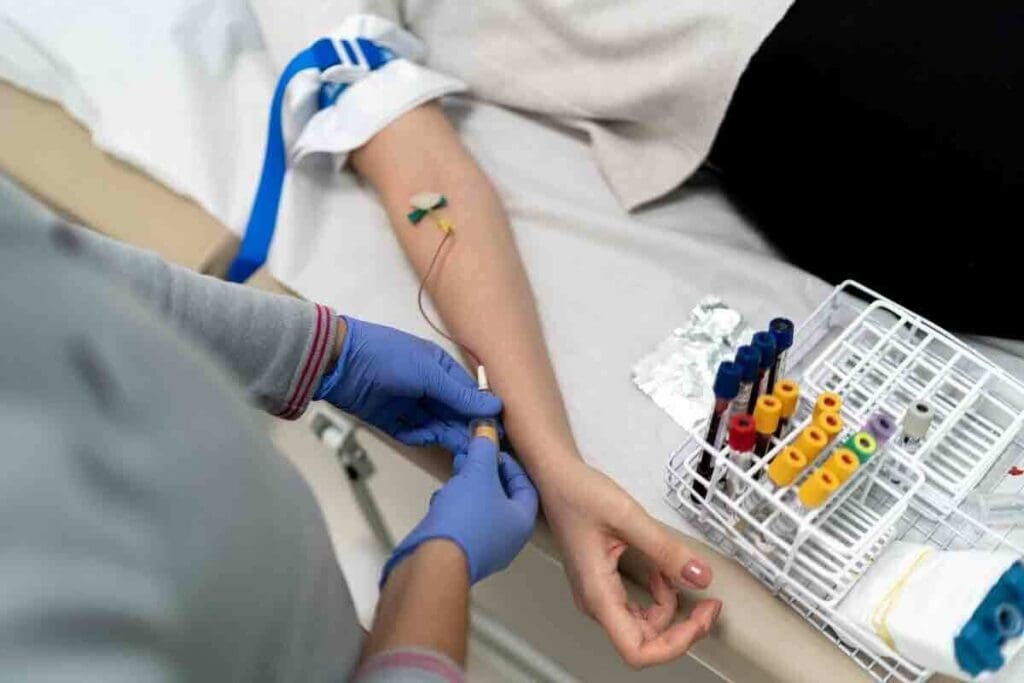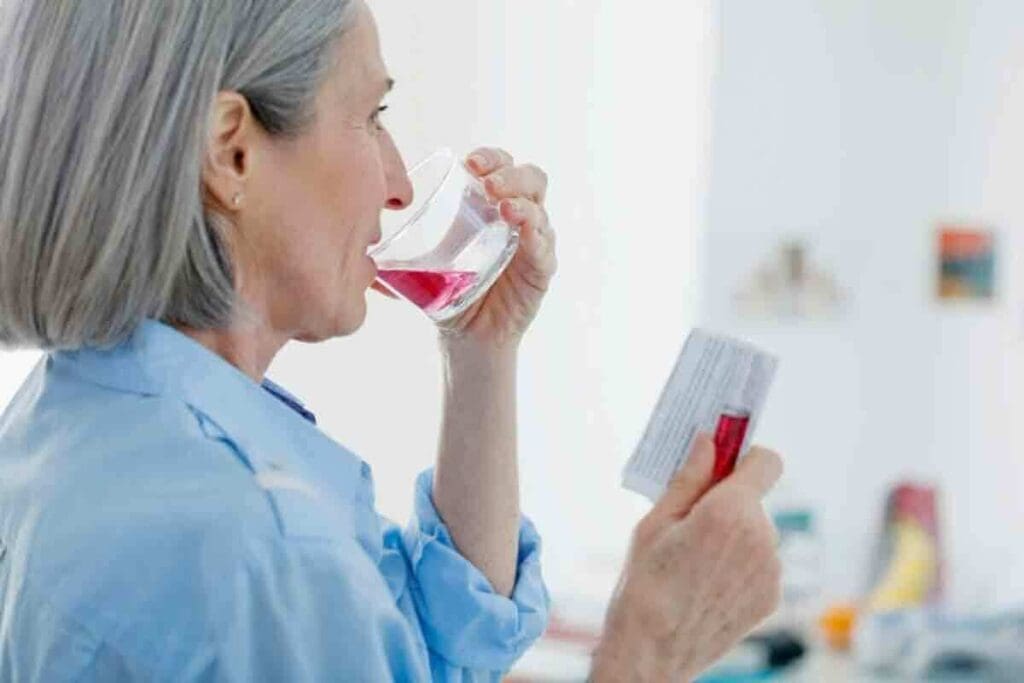Last Updated on November 14, 2025 by Ugurkan Demir

Hemoglobin is a key protein in red blood cells. It carries oxygen from the lungs to the body’s tissues. It also takes carbon dioxide back to the lungs for us to breathe out.
At Liv Hospital, we know how important optimal hemoglobin levels are for staying healthy. Hemoglobin levels tell us a lot about our health. They change based on age, sex, and overall health.
Knowing about hemoglobin and its role in carrying oxygen is key. It helps us understand and manage health issues. We’ll look into what hemoglobin is, why it’s important, and what affects its levels.

Hemoglobin is a protein in red blood cells. It’s key for moving oxygen and carbon dioxide around the body. This protein helps keep the right amount of oxygen in different tissues.
Hemoglobin is made of heme and globin parts. The heme has iron, which grabs onto oxygen. The globin part supports the heme. This mix lets hemoglobin do its job well.
Hemoglobin’s main job is to carry oxygen from the lungs to tissues. It picks up oxygen in the lungs and carries it to tissues. There, it releases oxygen for cells to use.
Oxygen Transport Mechanism: How well hemoglobin binds and releases oxygen changes with pH, temperature, and 2,3-BPG levels. These factors help match oxygen delivery to tissue needs.
Hemoglobin also moves carbon dioxide from tissues back to the lungs. Carbon dioxide is a waste from cell work. Hemoglobin binds to it, forming carbaminohemoglobin, and carries it to the lungs for breathing out.
Carbon Dioxide Transport: Hemoglobin’s ability to bind carbon dioxide is key for removing it. This helps keep the body’s acid-base balance right.
| Function | Description |
| Oxygen Transport | Transports oxygen from the lungs to the tissues |
| Carbon Dioxide Transport | Transports carbon dioxide from tissues to lungs |
| Regulation | Influenced by pH, temperature, and 2,3-BPG |

Hemoglobin is made up of protein chains and heme groups. It has four protein chains (globins) and four heme groups, each with iron. This complex structure is key for carrying oxygen around the body.
The iron-containing protein components in hemoglobin are vital. The iron in the heme groups holds onto oxygen. This lets hemoglobin carry oxygen from the lungs to the body’s tissues.
The heme groups in hemoglobin bind oxygen. Each group has an iron atom at its center. This iron is essential for oxygen binding, keeping oxygen levels balanced in the body.
Hemoglobin has four protein chains: two alpha-globin and two beta-globin. These chains are arranged in a specific way. This arrangement affects how well hemoglobin binds oxygen.
Each red blood cell has about 270 million hemoglobin molecules. This high number lets red blood cells carry oxygen efficiently. They meet the oxygen needs of different tissues in the body.
In summary, hemoglobin’s structure and composition are designed for oxygen transport. Knowing about these aspects helps us understand how hemoglobin works in the body.
Hemoglobin levels change a lot depending on who you are. It’s key to know these changes. They help keep red blood cells healthy and ensure oxygen gets to our tissues.
Adult males usually have hemoglobin levels between 13.5 and 17.5 grams per deciliter (g/dL). This can vary a bit based on the lab. But, levels in this range are usually considered normal.
Adult females have a lower normal hemoglobin range, from 12 to 16 g/dL. This is because of how sex hormones affect the production of red blood cells.
In kids, hemoglobin levels change a lot with age. Newborns have more, and it goes down as they grow. For older adults, hemoglobin levels can change, too. This is because of age and health issues.
Pregnancy brings changes in hemoglobin levels for women. This is because of more blood and other bodily changes. Levels below 11 g/dL in the first and third trimesters or below 10.5 g/dL in the second are considered low.
It’s key for healthcare folks and patients to grasp how hemoglobin is measured. Hemoglobin levels show our health, and getting them right is key to treatment.
Hemoglobin is measured in grams per deciliter (g/dL). This means the grams of hemoglobin in 100 milliliters of blood. The g/dL measurement is a standard unit used globally, making it easy to compare hemoglobin levels everywhere.
Even though g/dL is common, some places use other units. It’s important to know these differences to understand the results. For example, hemoglobin can also be in grams per liter (g/L) or millimoles per liter (mmol/L). Being able to switch between these units is key for correct diagnosis and treatment, whether it’s for local or international patients.
When looking at lab results, it’s important to see the reference ranges. These ranges show what’s normal for different people, like age and sex. Healthcare providers need to know about any factors that could change test results, like how the sample was handled or the patient’s health.
Knowing about hemoglobin units and how to read lab results helps healthcare providers make better choices for patients. It also helps patients understand their health better and what their test results mean.
Hemoglobin and red blood cells work together to move oxygen in our bodies. Hemoglobin is a protein in red blood cells. It carries oxygen from the lungs to our tissues and carbon dioxide back to the lungs.
Each red blood cell has a lot of hemoglobin, about 270 million hemoglobin molecules. This lets red blood cells carry a lot of oxygen. The amount of hemoglobin in red blood cells is key for delivering oxygen to our bodies.
Red blood cells are made in the bone marrow. This process, called erythropoiesis, is controlled by our body’s needs. Erythropoietin, a hormone from the kidneys, helps make more red blood cells when we need more oxygen.
Red blood cells live for about 120 days. They carry oxygen to our tissues and organs during this time. As they age, they lose flexibility and are removed by the spleen.
Knowing how hemoglobin and red blood cells work together helps us understand and treat problems. Keeping our hemoglobin and red blood cell counts healthy ensures we get enough oxygen.
Hemoglobin and hematocrit are key parts of a CBC test. They give important health insights. Knowing how they relate helps in diagnosing and treating blood disorders.
Hematocrit, or packed cell volume (PCV), shows the red blood cell percentage in blood. It’s a percentage that shows red blood cells’ volume compared to the total blood. Normal ranges vary by age, sex, and altitude.
Hematocrit and hemoglobin are linked because they both measure red blood cells. Hemoglobin carries oxygen in red blood cells. Hematocrit shows total red blood cell count, while hemoglobin measures the protein in those cells. Usually, they go hand in hand, but some conditions can change this.
Hematocrit and hemoglobin are key in diagnosing anemia and other red blood cell issues. They help see how severe anemia or polycythemia is and if treatment is working. These tests are also vital for patients with chronic diseases, those about to have surgery, and those with blood loss or dehydration.
Men and women have different normal hematocrit ranges. Adult men usually have a range of 40.7% to 50.3%. Adult women’s range is 36.1% to 48.3%. These can vary slightly by lab standards.
| Gender | Normal Hematocrit Range (%) |
| Male | 40.7 – 50.3 |
| Female | 36.1 – 48.3 |
It’s important for doctors to understand the link between hemoglobin and hematocrit. By looking at these values together, doctors can better understand a patient’s health. This helps in creating the right treatment plans.
Having the right hemoglobin levels is key to good health. Hemoglobin carries oxygen and carbon dioxide in our blood.
Optimal hemoglobin levels mean our body gets enough oxygen without getting tired. For adults, normal levels are between 13.5 and 17.5 g/dL for men and 12 to 16 g/dL for women. But, what’s best can change based on age, sex, and fitness.
Several things affect what’s considered optimal hemoglobin levels:
Many things can change what’s considered the best hemoglobin levels. For example:
For athletes, the right hemoglobin levels are important for better performance, mainly in long-distance sports. More hemoglobin means more oxygen for muscles, which can boost performance. But too much can make blood thicker and riskier for the heart.
Athletes and coaches should talk to doctors to find the best hemoglobin levels for them. They need to consider how hard they train, where they live, and how they’re different from others.
Levels of 12 g/dL and 16 g/dL are important for adults. A level of 12 g/dL is the normal minimum for women, and 16 g/dL is close to the maximum for men.
Being below 12 g/dL might mean anemia or other health problems. Being above 16 g/dL could mean dehydration or conditions like polycythemia. Knowing these values helps us and doctors make better health choices.
Low hemoglobin levels can affect your health a lot. It’s important to know why this happens. Hemoglobin is a protein in red blood cells that carries oxygen. If its levels are low, it can cause anemia.
Anemia is when you don’t have enough red blood cells or they’re not good enough. These cells are key to carrying oxygen. There are many types of anemia, like iron-deficiency anemia and vitamin deficiency anemia.
Iron-deficiency anemia is the most common. It happens when you don’t have enough iron. Vitamin deficiency anemia is caused by not having enough vitamins like B12 or folate. Anemia of chronic disease is linked to long-term illnesses. Sickle cell anemia is a genetic disorder that changes the shape of red blood cells.
Many things can cause low hemoglobin levels. These include not getting enough nutrients, chronic diseases, and genetic disorders. Some common causes are:
As the World Health Organization says, “Iron deficiency is the most common cause of anemia worldwide.”
“Anemia is a major public health problem worldwide, especially in developing countries.”
The symptoms of low hemoglobin levels can vary. They depend on how severe and what type of anemia you have. Common symptoms include:
| Symptom | Description |
| Fatigue | Feeling weak and tired |
| Pale skin | Skin appears pale or washed out |
| Shortness of breath | Difficulty breathing or feeling winded |
| Dizziness | Feeling lightheaded or dizzy |
Treating low hemoglobin levels means fixing the cause. Treatment can include:
Seeing a healthcare professional is key to the right diagnosis and treatment. Knowing the causes and effects of low hemoglobin levels helps us stay healthy.
It’s important to know why high hemoglobin levels happen and what they mean for our health. High hemoglobin can be due to polycythemia, a condition with too many red blood cells.
Polycythemia and erythrocytosis both mean having too many red blood cells. Polycythemia vera is a rare blood cancer that makes the bone marrow produce too many cells. Erythrocytosis is when there’s more red blood cell mass.
A medical expert says, “Polycythemia vera is a serious condition that can lead to significant health complications if not properly managed.”
“The diagnosis of polycythemia vera requires a thorough evaluation, including blood tests and bone marrow biopsy, to find the cause of high hemoglobin levels.”
Several factors can cause high hemoglobin levels. These include:
High hemoglobin levels can lead to several health problems. These include:
“It’s vital for individuals with high hemoglobin levels to work closely with their healthcare provider to manage their condition and mitigate risks.”
Managing high hemoglobin levels often involves treating the underlying cause. Strategies may include:
By understanding the causes and using the right management strategies, individuals with high hemoglobin levels can reduce their risk of health complications.
Eating well and living healthy are key to making hemoglobin. This protein is vital in red blood cells. Knowing what affects hemoglobin levels can help keep them healthy.
Iron is essential for making hemoglobin. Eating foods rich in iron helps keep hemoglobin levels up. Good sources include red meat, poultry, fish, beans, lentils, and fortified cereals.
There are two types of iron: heme and non-heme. Heme iron, found in animal products, is easier for the body to absorb.
Other nutrients are also important for hemoglobin. Vitamin B12, folate, and vitamin B6 help make red blood cells.
Exercise can change hemoglobin levels. Intense workouts might raise hemoglobin briefly. But regular, moderate exercise keeps the heart healthy and helps maintain hemoglobin levels.
Some habits can harm hemoglobin levels. Smoking lowers oxygen in the blood, affecting hemoglobin. Drinking too much alcohol can also lead to iron deficiency.
| Dietary Factor | Effect on Hemoglobin | Food Sources |
| Iron | Essential for hemoglobin production | Red meat, poultry, fish, beans, lentils, fortified cereals |
| Vitamin B12 | Supports red blood cell production | Meat, fish, dairy products |
| Folate | Crucial for red blood cell production | Leafy greens, legumes, fortified cereals |
| Vitamin B6 | Important for hemoglobin production | Meat, fish, whole grains |
Keeping hemoglobin levels in check is key to good health. Hemoglobin is vital for moving oxygen and carbon dioxide around the body. Knowing how important it is helps us stay healthy.
Eating right, staying active, and getting medical help when needed are important. Regular health checks and tests can spot any issues early. This way, we can act fast to keep our hemoglobin levels right.
In short, having healthy hemoglobin levels is critical for our bodies to work well. By understanding what affects hemoglobin and keeping it balanced, we can live better. This also helps avoid health problems linked to hemoglobin.
Hemoglobin levels vary by age and gender. For men, it’s usually between 13.5-17.5 g/dL. Women typically have levels between 12-16 g/dL.
The best hemoglobin levels are within the normal range for your age and gender. For adults, this means 13.5-17.5 g/dL for men and 12-16 g/dL for women.
Hemoglobin is measured in grams per deciliter (g/dL). This unit is used worldwide. Lab results are usually given in this measurement.
Hemoglobin and hematocrit are related but different. Hematocrit shows the red blood cell percentage in blood. Hemoglobin measures the amount of hemoglobin protein. Hematocrit is about three times the value of hemoglobin.
Low hemoglobin can come from many sources. These include iron or vitamin deficiencies, chronic diseases, and blood loss. These can cause anemia, a condition of low hemoglobin.
Signs of low hemoglobin include fatigue, weakness, and pale skin. You might also feel short of breath or dizzy. Severe cases can lead to serious health issues.
To keep hemoglobin healthy, eat a balanced diet with iron and vitamins. Exercise regularly and avoid habits that harm hemoglobin production. Regular health check-ups are also important.
Exercise can boost cardiovascular health and increase red blood cells. But intense or long exercise can change hemoglobin levels. It’s key to watch these changes.
High hemoglobin levels can raise the risk of blood clots, stroke, and heart issues. It’s vital to manage high hemoglobin to avoid these problems.
Diet, mainly iron intake, is key to healthy hemoglobin. Eating iron-rich foods and vitamins like B12 and folate is important.
Subscribe to our e-newsletter to stay informed about the latest innovations in the world of health and exclusive offers!